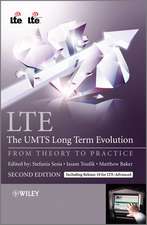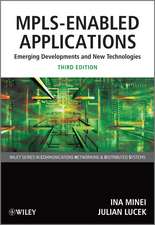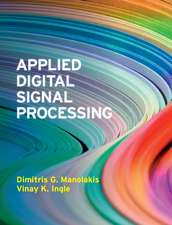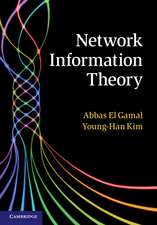Why Cryptography Should Not Rely on Physical Attack Complexity: T-Labs Series in Telecommunication Services
Autor Juliane Krämeren Limba Engleză Hardback – 23 sep 2015
First, the book introduces the photonic side channel, which offers not only temporal resolution, but also the highest possible spatial resolution. Due to the high cost of its initial implementation, it has not been taken seriously. The work shows both simple and differential photonic side channel analyses. Then, it presents a fault attack against pairing-based cryptography. Due to the need for at least two independent precise faults in a single pairing computation, it has not been taken seriously either.
Based on these two attacks, the book demonstrates that the assessment of physical attack complexity is error-prone, and as such cryptography should not rely on it. Cryptographic technologies have to be protected against all physical attacks, whether they have already been successfully implemented or not. The development of countermeasures does not require the successful execution of an attack but can already be carried out as soon as the principle of a side channel or a fault attack is sufficiently understood.
| Toate formatele și edițiile | Preț | Express |
|---|---|---|
| Paperback (1) | 633.02 lei 6-8 săpt. | |
| Springer Nature Singapore – 23 oct 2016 | 633.02 lei 6-8 săpt. | |
| Hardback (1) | 639.08 lei 6-8 săpt. | |
| Springer Nature Singapore – 23 sep 2015 | 639.08 lei 6-8 săpt. |
Din seria T-Labs Series in Telecommunication Services
- 15%
 Preț: 640.55 lei
Preț: 640.55 lei - 15%
 Preț: 641.20 lei
Preț: 641.20 lei - 15%
 Preț: 642.83 lei
Preț: 642.83 lei - 15%
 Preț: 639.25 lei
Preț: 639.25 lei - 24%
 Preț: 633.87 lei
Preț: 633.87 lei - 15%
 Preț: 642.03 lei
Preț: 642.03 lei - 20%
 Preț: 645.31 lei
Preț: 645.31 lei - 15%
 Preț: 644.63 lei
Preț: 644.63 lei - 20%
 Preț: 579.78 lei
Preț: 579.78 lei - 15%
 Preț: 641.53 lei
Preț: 641.53 lei - 15%
 Preț: 644.82 lei
Preț: 644.82 lei - 15%
 Preț: 638.24 lei
Preț: 638.24 lei - 20%
 Preț: 702.56 lei
Preț: 702.56 lei - 18%
 Preț: 999.45 lei
Preț: 999.45 lei - 15%
 Preț: 641.03 lei
Preț: 641.03 lei - 15%
 Preț: 637.46 lei
Preț: 637.46 lei - 18%
 Preț: 719.59 lei
Preț: 719.59 lei -
 Preț: 378.54 lei
Preț: 378.54 lei - 15%
 Preț: 637.13 lei
Preț: 637.13 lei - 15%
 Preț: 642.68 lei
Preț: 642.68 lei - 15%
 Preț: 640.06 lei
Preț: 640.06 lei - 15%
 Preț: 652.31 lei
Preț: 652.31 lei - 15%
 Preț: 642.03 lei
Preț: 642.03 lei -
 Preț: 386.61 lei
Preț: 386.61 lei - 20%
 Preț: 552.69 lei
Preț: 552.69 lei - 15%
 Preț: 645.47 lei
Preț: 645.47 lei - 15%
 Preț: 636.94 lei
Preț: 636.94 lei - 15%
 Preț: 642.18 lei
Preț: 642.18 lei - 15%
 Preț: 632.70 lei
Preț: 632.70 lei - 15%
 Preț: 638.24 lei
Preț: 638.24 lei - 20%
 Preț: 648.95 lei
Preț: 648.95 lei - 18%
 Preț: 943.57 lei
Preț: 943.57 lei
Preț: 639.08 lei
Preț vechi: 751.86 lei
-15% Nou
Puncte Express: 959
Preț estimativ în valută:
122.33€ • 132.92$ • 102.82£
122.33€ • 132.92$ • 102.82£
Carte tipărită la comandă
Livrare economică 21 aprilie-05 mai
Preluare comenzi: 021 569.72.76
Specificații
ISBN-13: 9789812877864
ISBN-10: 981287786X
Pagini: 122
Ilustrații: XXI, 122 p. 26 illus., 15 illus. in color.
Dimensiuni: 155 x 235 x 15 mm
Greutate: 0.38 kg
Ediția:1st ed. 2015
Editura: Springer Nature Singapore
Colecția Springer
Seria T-Labs Series in Telecommunication Services
Locul publicării:Singapore, Singapore
ISBN-10: 981287786X
Pagini: 122
Ilustrații: XXI, 122 p. 26 illus., 15 illus. in color.
Dimensiuni: 155 x 235 x 15 mm
Greutate: 0.38 kg
Ediția:1st ed. 2015
Editura: Springer Nature Singapore
Colecția Springer
Seria T-Labs Series in Telecommunication Services
Locul publicării:Singapore, Singapore
Public țintă
ResearchCuprins
Introduction.- Mathematical and Cryptological Background.- Photonic Emission Analysis.- The Photonic Side Channel.- Higher-Order Fault Attacks against Pairing Computations.- Future Work and Conclusion.
Textul de pe ultima copertă
This book presents two practical physical attacks. It shows how attackers can reveal the secret key of symmetric as well as asymmetric cryptographic algorithms based on these attacks, and presents countermeasures on the software and the hardware level that can help to prevent them in the future. Though their theory has been known for several years now, since neither attack has yet been successfully implemented in practice, they have generally not been considered a serious threat. In short, their physical attack complexity has been overestimated and the implied security threat has been underestimated.
First, the book introduces the photonic side channel, which offers not only temporal resolution, but also the highest possible spatial resolution. Due to the high cost of its initial implementation, it has not been taken seriously. The work shows both simple and differential photonic side channel analyses. Then, it presents a fault attack against pairing-based cryptography. Due to the need for at least two independent precise faults in a single pairing computation, it has not been taken seriously either.
Based on these two attacks, the book demonstrates that the assessment of physical attack complexity is error-prone, and as such cryptography should not rely on it. Cryptographic technologies have to be protected against all physical attacks, whether they have already been successfully implemented or not. The development of countermeasures does not require the successful execution of an attack but can already be carried out as soon as the principle of a side channel or a fault attack is sufficiently understood.
First, the book introduces the photonic side channel, which offers not only temporal resolution, but also the highest possible spatial resolution. Due to the high cost of its initial implementation, it has not been taken seriously. The work shows both simple and differential photonic side channel analyses. Then, it presents a fault attack against pairing-based cryptography. Due to the need for at least two independent precise faults in a single pairing computation, it has not been taken seriously either.
Based on these two attacks, the book demonstrates that the assessment of physical attack complexity is error-prone, and as such cryptography should not rely on it. Cryptographic technologies have to be protected against all physical attacks, whether they have already been successfully implemented or not. The development of countermeasures does not require the successful execution of an attack but can already be carried out as soon as the principle of a side channel or a fault attack is sufficiently understood.
Caracteristici
Presents two practical physical attacks, the complexity of which has been overestimated and the implied security threats of which have been underestimated Demonstrates that the assessment of physical attack complexity is error-prone and cryptography should not rely on it Demonstrates how attackers can reveal the secret key of cryptographic algorithms based on these physical attacks Includes supplementary material: sn.pub/extras












